InterCity
This articleneeds additional citations forverification.(November 2011) |

InterCity(commonly abbreviatedICon timetables and tickets) is the classification applied to certain long-distancepassenger trainservices in Europe. Such trains (in contrast to regional, local, or commuter trains) generally call at majorstationsonly.
An international variant of the InterCity trains are theEuroCity(EC) trains which consist of high-standard coaches and are run by a variety of operators.
History
[edit]The Inter-City Rapid Transit Company was anOhiointerurbancompany, which began operations in 1930 as it had purchased its route from the Northern Ohio Traction & Light Company. It remained in operation till 1940.[1]
The use ofInter-Citywas reborn in the United Kingdom: A dailytrain of that namewas introduced in 1950, running between the cities ofLondonandBirmingham.This usage can claim to be the origin of all later usages worldwide.
In 1966British Railintroduced the brand InterCity for all of its express train routes, and in 1986 the term was adopted by theInterCity sector of British Rail.Following the privatisation of the railways in Great Britain, the term is no longer in official use there although many people still refer to fast long-distance services as InterCity trains. The brand still exists though, and belongs to theDepartment for Transport.[2]

In West Germany, theDeutsche Bundesbahnfirst used the name (then writtenIntercity) in 1968, denoting special first-class services on theF-Zugtrain network. Many of theClass VT 11.5diesel multiple unitsformerly used on theTEEnetwork were converted for early Intercity services.
In Switzerland, the InterCity brand replaced SwissExpress in the 1982 schedule.
In Norway,intercity(later also writtenInterCity) trains were introduced in 1975 on the Vestfold Line (theOslo-Skienservice), later also on the Østfold Line (Oslo-Halden). They were (relatively) fast trains on distances up to 2–3 hours. Today, the name is used not on the trains, but on the main lines from Oslo to Skien,Lillehammer,and Halden – and also on the Ringerike Line, which is under construction from Oslo to Hønefoss.
An international variant of InterCity,EuroCity(EC), was introduced in May 1987. EuroCity trains consist of high-standard,air conditionedcoaches, are run by a variety of operators, and are usually subject to on-board border controls. For example, EuroCity trains running in Germany can be made up byrolling stockof either theSBB(Switzerland),ÖBB(Austria),SNCF(France), and less commonly by stock of the CzechČDand HungarianMÁVrailways.
InterCity by country
[edit]Austria
[edit]

TheAustrian Federal Railways(ÖBB) have operated IC services since 1991. However, contrary to most other countries, these are often little more thanregional rail,as most long-distance, high-standard trains in Austria are likely to beEuroCity(EC) services, even when not leaving the Austrian borders (namedÖBB-EuroCityuntil 2011). Modernised stock ofEurofima coachesis used under the brand nameÖBB-InterCity(OIC) mainly on the AustrianWesternandSouthern RailwaysfromViennatoSalzburgandVillach.
The ÖBB also deployedelectric multiple unittrains, from 2006 also threeICE T(Class 411, namedÖBB 4011) trainsets in cooperation with theDeutsche Bahn,currently running from Vienna toFrankfurtviaLinzandPassau.ÖBBhigh-speed railservice is provided byRailjet(RJ) trains.
Since 2011, there is an hourly express train service on the Western Railway operated byWESTbahn,the only long-distance competitor of the ÖBB.
IC-Services:
- Western Railway
- Southern Railway
- Vienna–Bruck an der Mur–Klagenfurt–Villach(every 2 hours with several trains running as EC)
- Vienna–Bruck an der Mur–Graz(every 2 hours with several trains running as EC, 4 trains heading toMaribor,LjubljanaandZagreb)
- Vienna–Wiener Neustadt–Mattersburg–Sopron–Csorna
- Graz–Klagenfurt (service is operating asIntercitybustill theKoralm Railwayis opened)
- North railway
- Enns Valley Railway
- Graz–Selzthal–Bischofshofen–Salzburg (4 trains per day).
- Graz–Leoben–Bischofshofen–Schwarzach/St. Veit–Innsbruck(1 train per day, additional EC trains toBregenzand as EN toZürich).
- Klagenfurt–(Beograd/Zagreb–)Villach–Bischofshofen–Salzburg (trains operating every 2 hours, services running toMunichandDortmund)
- Salzburg-Tyrol RailwayandLower Inn Valley Railway
- Arlberg railway
The InterCity service from Vienna to Salzburg is going to be expanded for an hourly service toLandeckvia Innsbruck by December 2008. Also, the service from Vienna to Graz is going to operate hourly by December 2008.
- Vienna-Košice Railway ( route Vienna-Bratislava-Žilina-Košice mainly on the territory ofSlovakia).
The IC44 and IC45 trains stop at Bratislava-Petržalka, Bratislava-Nové Mesto, Bratislava Hlavná Stanica, Trnava, Žilina, Poprad, and Kysak; it takes 6:22h for the whole journey.
InterCity stops in Austria:
- Western railway:Wien Westbahnhof,Wien Hütteldorf,Tullnerfeld,St. Pölten Hauptbahnhof,Amstetten, St. Valentin,Linz Hauptbahnhof,Wels Hauptbahnhof,Attnang-Puchheim, Vöcklabruck,Salzburg Hauptbahnhof
- Southern railway:Wien Südbahnhof,Wien Meidling,Wiener Neustadt Hauptbahnhof,Mürzzuschlag, Bruck an der Mur, Frohnleiten,Graz Hauptbahnhof,Wildon, Leibniz, Spielfeld-Straß
- Line from Bruck an der Mur to Villach: Bruck an der Mur,Leoben Hauptbahnhof,Knittelfeld, Zeltweg, Judenburg, Unzmarkt, Friesach in Kärnten, Treibach-Althofen, St.Veit an der Glan,Klagenfurt Hauptbahnhof,Krumpendorf am Wörthersee, Pörtschach am Wörthersee, Velden am Wörthersee,Villach Hauptbahnhof
- Line from Villach to Salzburg:Villach Hauptbahnhof,Spittal-Millstättersee, Mallnitz-Obervellach, Bad Gastein, Bad Hofgastein, Dorfgastein, Schwarzach-St.Veit, St. Johann im Pongau, Bischofshofen, Werfen, Golling-Abtenau, Hallein, Salzburg Süd, Salzburg Hauptbahnhof
Belgium
[edit]
InterCity trains link all major cities of Belgium. Some of them serve also destinations outside the country. The IC betweenLiègeandBrusselstravels at 200 km/h on theHSL 2.However, because of the density of the train network with many connecting lines and the many small- and medium-sized cities in Belgium, most IC services also call at smaller stations or continue as local trains on branch lines.
Croatia
[edit]
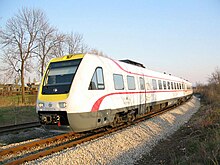
As of 2024, there are two InterCity services:
The coaches used are similar to the ones used in Germany by DB.
TrainsSlavonijaandCibaliaconnecting Zagreb andVinkovciwere part of IC network up to 2023, when they were downgraded to fast train (B). Speeds were up to 160 km/h betweenSlavonski BrodandVinkovci.
LineZagreb–Splitserved by tilting trains is designated as InterCity Nagibni (ICN).
Czech Republic
[edit]In theCzech Republic,the IC or Express trains service the following routes:
- Bohumín–Břeclav,
- Bohumín–Prague,
- Třinec–Prague,
- Cheb–Prague(served byPendolino tilting trainsets),
- Havířov–Prague.
Most of the IC are served by trains of state-owned operatorČeské dráhywith speeds up to 160 km/h but they have been converted into category Express in 2012 timetable. The other is served by trains of private operatorRegioJetwith speed up to 160 km/h. No surcharge is applied to IC trains but RegioJet runs reservation compulsory trains. Third private passenger operatorLEO Expressintroduced express InterCity train service between Prague and Ostrava in November 2012, with speeds up to 160 km/h.[3]
The state-owned operatorČeské dráhyalso serves linePrague–Ostrava(with some connections extended toBohumínandFrantiškovy Lázně) withPendolinotrainsets under designation "SuperCity",which conforms to IC standard. A compulsory reservation is applied on these trains.
Denmark
[edit]The Intercity network of theDanish State Railwaysconsists of IC trains and their faster version,Lyntog(Lightning Train), which is identical but with fewer stops. Each train type operates hourly between the eastern terminus at Copenhagen and westwards toOdense–Århus–Ålborg,and less frequently to alternative destinations inJutland.These are run byIC3diesel materiel since most of the network is not electrified. There are also electrical IC trains run byIR4sin an hourly schedule from Copenhagen westwards toOdenseand alternatelyEsbjerg/Sønderborg.This means during most of the day there are three trains an hour between Copenhagen and Odense. Quite unusual in the world, some trains will consist of both electrically and diesel-powered units coupled together. Being the only option for long-distance and some short-distance travel, there is no surcharge for IC and Lyntog. They have a maximum speed of 180 km/h. Additionally, there are a few IR trains during Friday and Sunday peak hours between Copenhagen and Århus. These are locomotive-run and havebilevel cars.The IC3 trains are planned to be replaced by newIC4trains, originally in 2001. They first ran with passengers in 2008, but haven't nearly replaced theIC3yet. It is now planned to give theIC3stock a 10-year life extension, and to eventually scrapIC4trains, due to the plague of poor reliability.IR4stock (Electric version ofIC3) will releaseIC3stock from the Esbjerg Line, allowing some IC3 trains to replaceIC4trains.
Finland
[edit]
In Finland,VRhas operatedInterCitytrains between major Finnish cities since August 1988.[4][5]The first routes were Helsinki–Vaasa and Helsinki–Imatra,[4]which later expanded to all major cities and include for instance Helsinki–Tampere–Oulu–Rovaniemi, Helsinki–Turku, Helsinki–Iisalmi and Helsinki–Joensuu. InterCity trains have become the standard as the Finnish long-distance rail travel mainstay, and their predecessors,blue-carriagedexpress trains, are being withdrawn off the schedules.[6]The train tickets include an additional surcharge compared to ordinary express trains: 17 to 27% depending on journey length.
VR operates both ordinaryInterCitytrains (IC) and entirely double-decker trains (IC²).[7]An ordinary IC train usually consists of 3 to 4 double-decker cars and 3 to 5 ordinary IC cars. In addition the train has a restaurant car.[5]IC² trains consist only of double-decker cars and have no separate restaurant car with a sales trolley moving about in the train.[7]However, due to high demand, VR ordered double-decker restaurant cars from Transtech in early 2011. The first carriages should be operational in 2013.[8]All IC-trains are smoke-free.[7]
The trains run at a maximum speed of 140–160 km/h for single-decker trains[5]and up to 200 kilometres per hour (120 mph) for double-deckers,[7]which was VR's aim in 1988.[4]Only thePendolinoandAllegrotrains are faster than InterCity trains in Finland.
France
[edit]In 2006, theSNCFrebranded Corail, Téoz and Lunéa services as 'Intercités', a brand for all of their 'classic' services day and night.
Germany
[edit]In Germany, the InterCity network was launched in 1971 to accompany and eventually replace theTrans Europ Expresstrains. At first, IC services were first-class only, often using TEE stock and the then-newClass 103locomotives. Trains ran bi-hourly. DB paid a royalty fee toBRfor many years for the use of thebrand name.
In 1978, it was decided to expand the IC network to services with both first and second class, and so the new scheme, calledIC '79was launched in 1979 with the motto"Jede Stunde, jede Klasse"( "every hour, every class" ) to emphasize its new structure. Large numbers of air-conditioned open coach cars, theBpmz 291,were built for InterCity services, which at first were using the TEE colour scheme. In 1985, with many of the TEE trains gone and the introduction of theInterRegio,the network was expanded again, now covering virtually any major city of then-West Germany.It faced further changes after theGerman reunificationand the introduction of theInterCityExpressin the early 1990s.
Today, after the abolition of the InterRegio in 2002, most long-distance connections in Germany are either IC or ICE trains; they most commonly offer at least bi-hourly service. Maximum speed for an IC is 200 km/h.
Greece
[edit]InGreece,InterCity trains operated by Italian government-ownedHellenic Trainrun in the following routes:
- Athens–Lamia–Larissa–Thessaloniki
- Athens–Lamia–Palaiofarsalos–Karditsa–Trikala–Kalambaka,one pair of trains per day at 160 km/h
- Thessaloniki–Serres–Drama–Xanthi-Alexandroupoli,one pair of trains per day at 160 km/h
Hungary
[edit]In Hungary the first InterCity train departed in 1991, since then almost 10 million people use these trains every year. Since then almost 250 InterCity trains operate in the country.
Intercity train services in Hungary:
- Budapest Déli pu–Pécs(Every 2–3 hours)
- Budapest Keleti pu–Pécs(Every 1–2 hours)
- Budapest Déli pu–Kaposvár–Nagykanizsa(Somogy IC)
- Budapest Déli pu.-Szekszárd-Baja(Gemenc IC)
- Budapest Keleti pu–Miskolc–Tiszai–Debrecen–Budapest Nyugati pu(Circle-IC, every 2 hours)
- Budapest Keleti pu–Miskolc–Tiszai(Every hour)
- Budapest Keleti pu–Győr–SopronandSzombathely(Every hour)
- Budapest Keleti pu–Békéscsaba–Timișoara/Târgu Mureș/Simeria/Brașov/București-Nord(Every 2h)
- Budapest Keleti pu-Békéscsaba-Lőkösháza(Every hour)
- Budapest Nyugati pu–Nyíregyháza(Every 2 hours)
- Budapest Nyugati pu–Szeged(Every hour)
The Hungarian intercity trains are operated by MÁV-START, the Hungarian railway company.
Ireland
[edit]In theRepublic of Ireland,Iarnród Éireannintroduced the brand name InterCity in 1984, replacing the previous name ofMainline,which had been introduced in 1976. Initially applied to services operated byBritish Rail Mark 3trains, it was later extended to include all services not part of theDublin Suburban Railnetwork. Today the brand encompasses services betweenDublinandCork,Galway,Limerick,Tralee,Waterford,Sligo,Westport,Rosslare Europort,Ballina,andEnnis,as well as some regional services. A new InterCity logo was introduced in 2006, though the vast majority of rolling stock bore the original script logo and orange-tan livery until the final Mark 3 set was withdrawn in 2009. Since Ireland completed its replacement of the old Mark 2 and Mark 3 stock in 2012, it has one of the most modern InterCity fleets in the world.
Northern Ireland RailwaysandIarnród Éireannboth formerly operated trains on theDublin–Belfastline under the InterCity brand, however this was replaced with the revivedEnterprisebrand name upon the introduction of theDe Dietrich Ferroviairerolling stock in 1997. This, coupled with the subsequent withdrawal of most coaching stock bearing the logo and the rebrand to the Translink name, means that the InterCity brand has largely disappeared from Northern Ireland Railways.
Italy
[edit]
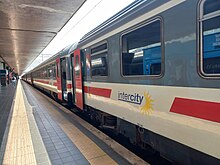
InItaly,InterCity trains constitute a capillary network that links the main cities across the peninsula. There were over 80-day (InterCity Sun) and night (InterCity Notte) services. Things changed with the opening of high-speed lines and the mixed public-private service. With the introduction of high-speed trains, intercity trains are limited to few services per day on mainline and regional tracks.
The daytime services (InterCityIC), while not frequent and limited to one or two trains per route, are essential in providing access to cities and towns off the railway's mainline network. The main routes areTriestetoRome(stopping atVenice,Bologna,Prato,FlorenceandArezzo),Milanto Rome (stopping atGenoa,La Spezia,PisaandLivorno/ stopping atParma,Modena,Bologna, Prato, Florence and Arezzo), Bologna toLecce(stopping atRimini,Ancona,Pescara,BariandBrindisi) and Rome toReggio di Calabria(stopping atLatinaandNaples). In addition, the Intercity trains provide a more economical means of long-distance rail travel within Italy.
The night trains (Intercity NotteICN) have sleeper compartments and washrooms, but no showers on board (available only forExcelsiorcarriages[9]). Main routes are Rome toBolzano/Bozen (calling at Florence, Bologna,Verona,RoveretoandTrento), Milan toLecce(calling at Piacenza, Parma, Reggio Emilia, Modena, Bologna, Faenza, Forlì, Cesena, Rimini, Ancona, Pescara, Bari and Brindisi),Turinto Lecce (calling atAlessandria,Voghera,Piacenza,Parma, Bologna, Rimini, Pescara, Termoli, San Severo,Foggia, Barletta, Bisceglie, Molfetta, Bari, Monopoli, Fasano, Ostuni and Brindisi) and Reggio di Calabria to Turin (calling at Naples, Rome,Livorno,La Spezia and Genova). Most portions of these ICN services run during the night; since most services take 10 to 15 hours to complete a one-way journey, their day-time portion provide extra train connections to complement with the Intercity services.
There are a total of 86 intercity trains running within Italy per day.
Netherlands
[edit]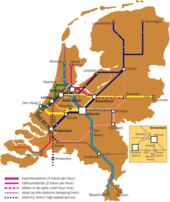
Intercity trains are very common in the Netherlands, but may differ from each other. While some intercity trains call only at larger stations, some others may also call at smaller stations or at all intermediate stations along a short stretch of its route. Hence, some stations may be served by one intercity train while another may pass it. For example, the Intercity trains betweenArnhem Central stationandUtrecht Central stationalternately serveDriebergen-ZeistorVeenendaal-De Klomp(and both when the frequency is lowered from 4tph to 2tph in the evening). Often, intercity trains run as local trains along the very end of its route. For example, theNijmegentoDen Helderintercity runs as regular intercity until Alkmaar, serving larger stations only, but running as local train between Alkmaar and Den Helder, serving all intermediate stations.
The average distance between station is shorter than most IC trains in most other countries, but frequencies are higher. All lines are served at least with 2tph, but many busy stretches are served have 4tph. From Utrecht Central there are even two different services to Amsterdam, one that serves thecentral stationand two others and another that serves thesouth stationand theairport.From December 2017 the frequency between Amsterdam, Utrecht and Eindhoven will be further increased to 6tph.
Rolling stock used mostly for intercity services in the Netherlands isVIRM.DD-ARtrains have been converted to be used asNew Intercity Double deckersand have been introduced to parts of the intercity network. Also, olderICM(formerly known as Koploper) EMUs are frequently seen on intercity routes.ICRm coaches,pulled by aTRAXXlocomotive, can be seen on international stretches and theIntercity Direct.
Poland
[edit]
In Poland IC trains operated byPKP IntercityS.A. up to 2009 served the following routes:
- Warsaw–Katowice/Krakówwith speed up to 200 km/h.
- Warsaw–Katowice–Bielsko-Białawith speed up to 160 km/h
- Warsaw–Katowice–Gliwicewith speed up to 160 km/h
- Warsaw–Poznań–Wrocławwith speed up to 160 km/h
- Warsaw–Katowice–Opole–Wrocław with speed up to 160 km/h
- Warsaw–Poznań–Szczecinwith speed up to 160 km/h
- Warsaw–Gdańsk–Gdyniawith speed up to 200 km/h
- Warsaw–Dęblin–Lublinwith speed up to 160 km/h
- Gdynia–Warsaw–Kraków with speed up to 200 km/h
- Gdynia–Warsaw–Gliwice with speed up to 160 km/h
- Szczecin–Berlin–Amsterdam Zuid WTC–Schiphol(jointly operated by PKP Intercity andDeutsche Bahn)

Apart from a single railway line (line nr 4, a.k.a.Centralna Magistrala Kolejowa–Central Railway Route), average speeds are much lower.
These trains mostly use the locomotive namedEurosprinter(EU44),EP09,sometimesEP08.
In 2009 IC category was renamedExpress InterCity(EIC). Since December 2014ICtrains are regular express andfast trains(with pricing offers like TLK fast trains), also operated by PKP Intercity, mainly utilizing high-standardPesa Dart(ED161) andStadler FLIRT3(ED160)electric multiple units.In addition to the EMU trains are served with refurbished cars pulled byEU07, EP07,andEP08locomotives.
Portugal
[edit]InPortugal,InterCidades trains are operated by state-ownedComboios de Portugal(CP).
All routes (except Casa Branca to Beja) are operated using a5600 Series electric locomotivespulling Corail and Modernized Sorefame passenger cars, all capable of running at a maximum speed of 200 km/h. This services have a Bar car and bicycle space.
The Casa Branca to Beja Shuttle service is operated using two0450 SeriesDMUs with airline style interiors at a maximum speed of 120 km/h. Although this service is branded as InterCidades, it is truly a stopper service (like a Regional service) with lower comfort standards and no Bar car or vending machines. This service is expected to have a quality boost when the newStadler FLIRT BMUunits enter operations sometime after 2025.
The InterCidades network can be divided into the following:
- InterCidades Norte:connectsLisbonwithnorthern Portugal.It complements theAlfa Pendularservices so that, in average, there is one train per hour between Lisbon andPorto.It has the following routes and frequencies:
- Lisbon (Santa Apolónia)-Porto (Campanhã):3 trains per day;
- Lisbon (Santa Apolónia)-Porto (Campanhã)-Braga:2 trains per day;
- Lisbon (Santa Apolónia)-Porto (Campanhã)-Guimarães:1 train per day;
- Lisbon (Santa Apolónia)-Porto (Campanhã)-Viana do Castelo:1 train per day - Saturday service terminates at Porto and Sunday service begins at Porto;
- Intercidades Beira Alta:connectsLisbonwith Guarda via Coimbra andMangualdethrough thePortuguese central highlands.It complements the InterCidades Norte services between Lisbon and Coimbra and has the following route and frequencies:
- Lisbon (Santa Apolónia)-Coimbra-Guarda:3 trains per day;
- Intercidades Beira Baixa:connects Lisbon with Covilhã viaAbrantesandCastelo Brancofollowing most of theTagusvalley before turning north towards thePortuguese central highlands.It complements the InterCidades Norte services between Lisbon andEntroncamentoand has the following route and frequencies:
- Lisbon (Santa Apolónia)-Entroncamento-Covilhã:3 trains per day;
- InterCidades Alentejo:connects Lisbon with theAlentejocapitals of Évora and Beja through the Alentejo plains. It has the following route and frequencies:
- Lisbon (Oriente)- Casa Branca -Évora:4 trains per day on weekdays and 3 trains per day on weekends and holidays;
- Casa Branca -Beja:4 trains per day on weekdays and 3 trains per day on weekends and holidays;
- InterCidades Sul:connects Lisbon with Faro through the Alentejo plains and theAlgarveHills. It complements the two daily Porto - FaroAlfa Pendularservices and has the following route and frequencies:
- Lisbon (Oriente)-Faro:3 trains per day with one extra summer Fridays service to Faro and one extra summer Sundays service to Lisbon.
Note: All frequencies listed above refer to round trips, so 1 train per day means 1 train per day each way.
Romania
[edit]This article needs to beupdated.The reason given is: InterCity trains have been cancelled on the whole Romanian Railways network in 2014, and have been reintroduced in December 2022, however this section mostly describes the pre-2014 state of the network.(April 2023) |
Currently[when?]InterCity lines link the capitalBucharesttoBrașov,Arad,Oradea,Cluj-Napoca,Târgu Mureș,Galați(all once daily),Suceava,Iași(twice daily),Piatra Neamț(once daily),Bacău(4x daily),Ploiești(6x daily),Craiova(twice daily) andTimișoara(once daily). There are also international trains branded as InterCity between the Hungarian capital,Budapestand someTransylvaniancities such asCluj-Napoca,Târgu Mureș,Brașov,and others. These trains usually have specific names (Harghita,Ady Endre,etc.).
In the case of IC service running partially or totally on electrified lines as well as international IC-s locomotive-hauled trains are used. For some trains running exclusively on unelectrified lines (mainly in northernTransilvania)Siemens DesiroDMU-s are preferred. These trainsets look similar to standard Desiro DMU-s used for regional trains but have a different interior design with more comfortable seating.
All IC trains use 1st and 2nd class coaches with air conditioning, having automatic doors and a higher level of comfort than InterRegio trains. In order to compete with regional airlines,CFR Călătoriintroduced specialBusiness classcoaches on the IC trains running betweenOradeaandBucharestandTimișoaraandBucharest.The new class can be divided into two slightly different premium service levels,Business Exclusiv(1A) andBusiness Standard(1B). All of these coaches have wireless internet and wall sockets in order to permit the use of laptops, 4 channel audio system, bar, Exclusiv further providing larger space per customer, special leather seating and LCD screens for each seat.
The maximum speed on theRomanian Railwaysnetwork is 160 km/h on theBucharest - Constanța line,140 km/h on theBucharest - Ploiești - Câmpina lineas well as on some sections of theLine 500.The design speed for the rest of the network is either 120 km/h or 100 km/h.
In 2014, InterCity trains were replaced in their entirety by InterRegio trains, only to make an illegal comeback (train sets do not respect all the obligatory criteria for InterCity trains ironically signed by the same government a few months prior to their comeback) in 2022, with the new train timelist.[10][opinion]
Serbia
[edit]From March 2022, state company calledSrbija Vozoperates InterCity route fromBelgrade,the capital, toNovi Sadusing 3Stadler KISSEMUsreaching speeds up to 200 km/h, with journey length of 36 minutes.[11]A massive expansion of IC routes is planned after the completion ofBelgrade – Budapestand Belgrade –Nišhigh-speed lines.
Slovakia
[edit]In theSlovak Republic,InterCity trains run between the capitalBratislavaandKošice(some IC trains continued from Bratislava toVienna). In the past, the names of some of these trains used to be sold for commercial use (ICŠarišnamed by beer producer, ICZelmernamed by an electronic devices producer, ICSlovenkanamed by a magazine, IC Mora, IC Gorenje, both named after kitchen appliances producers). In 2012, no IC train had commercial name. All IC trains are named by natural monuments (IC Tatran, IC Kriváň, IC Gerlach, IC Rysy, IC Chopok, IC Ďumbier). All IC trains are subject tocompulsory reservationto make comfort as high as possible. The seat reservation is included in the ticket price. The price varies, depending on the day of travel, and the time of reservation (the sooner you buy a ticket, the lower the price).
In the past, there were also 3 other InterCity services: IC 400/407 Donau (Danube) between Bratislava and Vienna, IC 532/533Rákoczifrom Košice toBudapestand IC 536/537Hornádfrom Košice toPécs.On this train passengers could travel without a reservation or surcharge, since it is impossible to use them for domestic transport in Slovakia.
All InterCity trains consist of new comfortablecarswhich are fullyair conditioned.
First classand arestaurant carare available on all IC trains.
Maximum speed betweenBratislavaandNové Mesto nad Váhomhas been increased in the recent years and is now 160 km/h. On the rest of the route, maximum speed varies from 80 to 140 km/h. There is a large reconstruction under way between Nové Mesto nad Váhom and Žilina. After the reconstruction is finished, it will be possible to increase maximum speed of this part of the route to 160 km/h.
Slovenia
[edit]Intercity trains in Slovenia mainly serve domestic routes, like running from Ljubljana (capital) to Celje, Ptuj, and Maribor. Additionally, there are also available Pendolino electric multiple tilting units ETR 310 (SŽ series 310) labeled as ICS lines connecting Slovenian largest cities, Ljubljana and Maribor and the Mediterranean region of Slovenia, Koper.
Spain
[edit]Renfeoperates intercity trains in Spain. It was a long-distance train with high frequency. This denomination was created firstly in 1980. It started operating theelectric train (EMU)Renfe 444 series, making theMadrid-ValenciavíaAlbaceteline. It was capable of doing 140 km/h (87 mph).
In 1986 it expanded toBarcelonaand Zaragoza, it was capable of doing 160 km/h (99 mph). In 1987 Renfe received new 448 series electric trains, those also being capable of doing 160 km/h. In the main lines this service was combined with fast trains or Talgos. In the less used lines it was a once a day train, as daily fast train. The last line wasIrún-Madrid,operated by a 448 series. This service closed in 2008.
In 2012 they opened new lines with the same denomination, making medium and long-distance routes.
The main differences between this line and the other ones is that it has more stops, trains stop in some lines every 15 minutes or less.[12]
This service can be divided in 3 categories:
-New lines using old Medium distance tracks, but with more stops.
-Long-distance routes with intercityfares.
-Old MD (Medium distance) lines, some of them are two older MD lines together.[13]
Sweden
[edit]

During the 1980s, InterCity denoted trains of the highest standard in Sweden, serving as a fast and comfortable connection between major Swedish cities. Trains used to be set up of the most modern cars, always including a restaurant car. During the 1990s theSwedish State Railwaysintroduced the newX 2000units which replaced the InterCity trains in this role. Since then, the InterCity trains serve an auxiliary role, calling at smaller stations and providing a cheaper alternative for the costly X 2000. They are set up of modernised cars pulled byRc6 locomotiveswith a maximum speed of 160 km/h. They serve the following lines:
- Stockholm–Arlanda–Uppsala–Sala–Avesta–Hedemora–Säter–Borlänge–Falun.Some trains continue from Borlänge viaGagnef–Leksand–RättviktowardsMora;
- Stockholm–Arlanda–Uppsala–Gävle–Ljusdal–Ånge–Bräcke–Östersund–Åre–Duved;
- Stockholm–Arlanda–Uppsala–Gävle–Söderhamn–Hudiksvall–Sundsvall;
- Stockholm–Södertälje–Hallsberg–Skövde–Herrljunga–Gothenburg;
- Stockholm–Södertälje–Norrköping–Linköping–Nässjö–Hässleholm–Lund–Malmö;
- Gothenburg–Varberg–Falkenberg–Halmstad–Hässleholm–Lund–Malmö;
- Luleå–Boden–Gällivare–Kiruna–Narvik.
Apart from the SJ, there are other train operators in Sweden who also run trains of a similar type. Only SJ, however, uses the name "InterCity".
Switzerland
[edit]
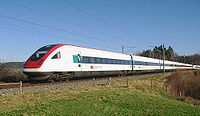

Swiss InterCity services started in 1982, replacing theSwiss Expresson the line Geneva-St. Gallen. There is no surcharge for InterCity services in Switzerland and the rolling stock consists of three types of formations:[14]
- Standard type IV carriages (German:EW IV,Einheitswagen IV) and driving trailers of type IC, the same as onInterRegioservices. A normal train composition consists of aRe 460locomotive, 8 to 12 carriages and a driving trailer. Seating capacity is up to 900, depending on the train composition. Most carriages have a small compartment for storing bicycles and/or skis at one end of the carriage; this end is marked by a bicycle drawn on the outside of the closest doors. The type IV carriages are the least wheelchair friendly as they require climbing the stairs to enter. Overall, 533 carriages and driving trailers are in operation.
- Double-deckerIC 2000carriages for lines with heavy commuter load. These trains are also powered by aRe 460locomotive, can be composed of up to 9 carriages with one driving trailer and offer close to 1,000 seats. At present, about 320 carriages are in use.
- Atilting traincategory calledICNfor lines with many curves. These trains areelectric multiple unitsand hence require no locomotive. One such multiple unit consists of 7 carriages and has aseating capacityof 480 passengers: 125 in first class, 332 in second class, and 23 in the dining car (which is part of second class). The fleet of ICN trains comprise 44 units.
If needed, two ICN trains can be combined to double the passenger capacity. In addition, several type IV carriages can be attached to an IC 2000 train set on the other side of the locomotive, especially if a group reservation requires extra carriages.
All carriages are air conditioned. Each train formation has first and second class carriages and, in most cases, a restaurant/bistro carriage. The availability of power sockets is constantly improved, sometimes even in second class. The maximal speed of all train types is 200 km/h, except for about half of type IV carriages that have not yet been upgraded and have a maximum speed of 160 km/h.
InterCity trains serve most of Swiss cities and provide direct connections from Zürich and Geneva airports. The InterCity routes within Switzerland according to 2009–2010 schedule include:
- Lugano – Bellinzona – Arth-Goldau – Luzern - Zug – Zürich HB;
- Interlaken Ost – Interlaken West – ( Därligen – Leissigen – Faulensee ) – Spiez – Thun – ( Münsingen ) – Bern – Olten – ( Liestal ) – Basel SBB;
- Brig – Visp – ( Frutigen ) – Spiez – Thun – Bern – ( Olten ) – Zürich HB – Zürich Flughafen – Winterthur – Frauenfeld – Weinfelden – ( Sulgen ) – Amriswil – Romanshorn;
- Brig – Visp – Spiez – Thun – Bern – Olten – Liestal – Basel SBB;
- Chur – Landquart – Sargans – ( Ziegelbrücke ) – Zürich HB – Basel SBB;
- Genève-Aéroport – Genève – ( Nyon – Morges ) – Lausanne – Fribourg – Bern – ( Olten – Aarau – Lenzburg ) – Zürich HB – Zürich Flughafen – Winterthur – Wil – Uzwil – Flawil – Gossau SG – St. Gallen;
as well as the following routes served by tiltingICNs:
- Bern – Zürich HB;
- Lausanne – ( Renens VD ) – Yverdon-les-Bains – Neuchâtel – Biel/Bienne – ( Grenchen Süd ) – Solothurn – ( Oensingen ) – Olten – Aarau – ( Lenzburg ) – Zürich HB – ( Zürich Oerlikon ) – Zürich Flughafen – Winterthur – Wil – ( Uzwil – Flawil ) – Gossau SG – St. Gallen;
- Lausanne – Yverdon-les-Bains – Neuchâtel – Biel/Bienne – Grenchen Nord – Moutier – Delémont – Laufen – Basel SBB;
- Genève-Aéroport – Genève – Nyon – Morges – Yverdon-les-Bains – Neuchâtel – Biel/Bienne – ( Grenchen Süd ) – Solothurn – Olten – Aarau – Zürich HB – Zürich Flughafen – Winterthur – Wil – ( Uzwil – Flawil ) – Gossau SG – St. Gallen;
- Genève-Aéroport – Genève – Nyon – Morges – Yverdon-les-Bains – Neuchâtel – Biel/Bienne – Grenchen Nord – Moutier – Delémont – Laufen – Basel SBB;
- Chur – Landquart – Sargans – Zürich HB – Basel SBB;
- Chiasso – Mendrisio – Lugano – Bellinzona – ( Flüelen – ) Arth-Goldau – Zug – Zürich HB;
- Chiasso – ( Mendrisio ) – Lugano – Bellinzona – Arth-Goldau – Luzern – Olten – Basel SBB.
This sectionneeds expansion.You can help byadding to it.(June 2008) |
Ukraine
[edit]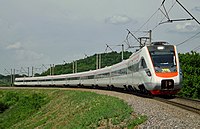
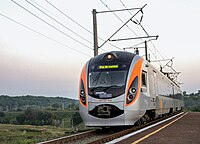
Intercity+ (max. 160 km/h[1]) train services in Ukraine[2]:
- Kyiv–Kharkiv
- Kyiv–Zaporizhzhia
- Kyiv–Dnipro
- Kyiv Darnytsia–Lviv–Przemysl
- Kyiv Darnytsia–Lviv–Truskavets
- Kyiv Darnytsia–Odesa
There were trains from Kharkiv and Dnipro to Crimea and from Kyiv to Donetsk. They were suspended in 2014, shortly after Ukraine have lost control of some of its territories. Currently, a shortened connection to Donbas is in service:
These services are operated by Hyundai RotemHRCS2,Škoda UZ class 675,KVBZEkr1"Tarpan" trains, andKVBZ"Ukrajina" locomotive-hauled train[3].
Intercity (70 km/h – 90 km/h) train services in Ukraine[4]:
- Kyiv Darnytsia–Lviv
- Kyiv–Kryvyi Rih
- Kharkiv–Kyiv–Vinnytsia
- Kharkiv–Donetsk(Suspended in 2014)
- Dnipro–Donetsk(Suspended in 2014)
Intercity and Intercity+ trains are operated by Ukrainian Rapid Railway Company (a branch ofUkrzaliznytsia)[5].
United Kingdom
[edit]
The term "Inter-City" was first used by the state railway companyBritish Railin 1966, tobrandall its longer-distance, higher-speed services (the hyphen was dropped shortly afterwards, changing the name to "InterCity" ). The brand was closely associated with a new design of carriage, theMark 2which revolutionised levels of comfort on the system. The system was hugely successful and became one of the world's few profitable public railway services.
Today, Britain's railways having been privatised, InterCity trains in the UK are operated by many different train companies includingGreater Anglia,Avanti West Coast,CrossCountry,Great Western Railway,London North Eastern Railway,East Midlands Railway,Hull Trains,Lumo,Transport for Wales,Abellio ScotRail,TransPennine Express,Caledonian Sleeper,Grand CentralandEurostar.Most of these companies operate their services from one of the many London termini, withCrossCountrybeing the exception, running fromCornwalltoScotland.If travelling via London it is often necessary to change stations: a journey fromNorwichtoCardiffwould require a transfer fromLondon Liverpool StreettoLondon Paddingtonstation via theLondon Underground.
Currently, InterCity trains in United Kingdom mainly use Hitachi AT300 in the form ofClass 800,Class 801,Class 802,Class 803,Class 805,Class 807andClass 810.InterCity 125(Class 43 power car + 4/5/8 Mark 3 coaches, also named as HST),InterCity 225(Class 91 + 9 Mark 4 coaches),Class 90+ 8/9 Mark 3 coaches +Driving Van Trailer,Voyager familyclasses220,221&222(4–7 coach DEMUs),class 180(5 coach DMUs),Class 745,andclass 390(9 or 11 coach EMUs) on the Intercity lines.
The British Government have named their project to replace theInterCity 125as well asInterCity 225as theIntercity Express Programme.The resultant bidding process was won byHitachiandAngel Trainsand resulted in the Hitachi Super Express Trains being introduced, which Hitachi later designated the AT300.
See also
[edit]References
[edit]- ^"Interurbans and Trolleys (Trains): History/Photos".
- ^"Trademark registration UKUK00001277000 -" INTERCITY "".Intellectual Property Office.
- ^"LEO Express carries first passengers".Archived fromthe originalon 13 June 2018.Retrieved4 May2014.
- ^abcHämäläinen, Raimo (1988). "Mannermaisuutta kiskoille".Tekniikan Maailma(in Finnish) (13).Yhtyneet Kuvalehdet:42–43.ISSN0355-4287.
- ^abc"InterCity".VR Group.Retrieved22 February2011.
- ^"VR:n siniset junavaunut poistuvat uusien vihreiden vaunujen tieltä".Salon Seudun Sanomat(in Finnish). 18 May 2011. Archived fromthe originalon 30 March 2012.Retrieved16 August2011.
- ^abcd"InterCity".VR Group.Retrieved22 February2011.
- ^"VR tilaa kaksikerroksisia ravintolavaunuja".STT(in Finnish).Iltalehti.24 March 2011. Archived fromthe originalon 26 March 2011.Retrieved16 August2011.
- ^"Trenitalia: Excelsior carriages".Trenitalia(in Italian).
- ^"Noile trenuri Intercity riscă să fie ilegale. Bani în plus pentru nimic".Club Feroviar.3 November 2022.Retrieved12 December2022.
- ^Први брзи воз у историји Србије(in Serbian)
- ^(In Spanish)http:// farodevigo.es/gran-vigo/2012/06/15/renfe-estrena-tren-vigo-madrid-diez-horas-paradas-15-minutos/657145.html
- ^Most of this article was a translation from the Spanish versiones:Intercity (Renfe)[circular reference]
- ^"SBB: Trains – Long-distance traffic".Archived fromthe originalon 15 August 2010.Retrieved24 May2010.
